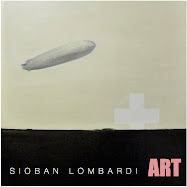
Gary Hume: Yardwork is the eighth exhibition of the artist’s work at Matthew Marks. Hume, frequently identified with the Young British Artists (YBAs) and Britain’s entry for the 1999 Venice Biennale, continues to create large, non-narrative enamel on aluminum paintings that depict his usual and customary subjects: women, birds, doors and flowers. In the past, Hume incorporated appropriated imagery. In the 13 paintings exhibited here, all created in 2008 and 2009, the majority of his imagery is gleaned from his farm in upstate New York.
The works demonstrate a notable contrast between pastoral and interior subject matter and their execution in decidedly urban colors and industrial materials. Another contrast, Hume creates quiet, sometimes mysterious paintings with surfaces as hard and real as a new car. Hume is most successful when his subjects cannot be immediately identified. Both Bird with a Pink Beak, and Perch can be viewed as entirely abstract paintings when first encountered, the organic shapes reminiscent of Joan Miro’s works from the early 1960’s including Bleu II and Hands Catching a Bird.
When Hume veers towards the traditionally representational, as in Two Roses, his paintings border on the merely decorative. This occurs among paintings sharing the same subject matter. Four Ponytails, has entirely abstract sensibilities enhanced by the use of industrial blue-grey, yellow and black. In contrast, works such as Red Ponytail, the subject is immediately recognizable, and in this context, far less interesting.
Finally, two works from which the show appears to have signaled its impetus and title, Tan Barn Door, and Red Barn Door, are striking in their simplicity, while paying homage to Hume’s early industrial and hospital doors exhibited in 1988 at Frieze, the Goldsmith’s show that marked the entrée of Hume and the YBA’s into the art world. Indeed, Hume’s relocation to a farm in upstate New York may reveal the show’s undercurrent. While individual works may not always be successful, interest in this show lies in Hume’s continued attempt to marry sometimes-opposing images, colors and materials; and reflect the investigation of the artist’s practice and craft, devoid of earlier more sensational notoriety.



No comments:
Post a Comment